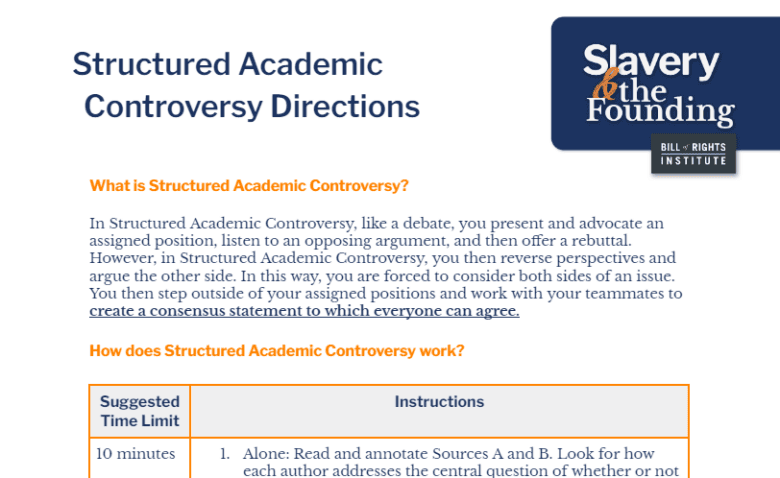Structured Academic Controversy
What is Structured Academic Controversy?
In Structured Academic Controversy, like a debate, you present and advocate an assigned position, listen to an opposing argument, and then offer a rebuttal. However, in Structured Academic Controversy, you then reverse perspectives and argue the other side. In this way, you are forced to consider both sides of an issue. You then step outside of your assigned positions and work with your teammates to create a consensus statement to which everyone can agree.
How does Structured Academic Controversy work?
| Suggested Time Limit | Instructions |
| 10 minutes | 1. Alone: Read and annotate Sources A and B. Look for how each author addresses the central question of whether or not the Constitution is a pro-slavery document. Write down the central argument of each author in the graphic organizer. |
| Break into small groups and assign teams. | |
| 5-10 minutes | 2. Teams brainstorm reasons to support the side they have been assigned and prepare arguments for their position. Use the text to build your argument. |
| 4 minutes (2 and 2) | 3. Each team has 2 minutes to state its views and arguments without interruption from the opposing team. Take notes when the other team presents its position. Team A begins and only Team A may speak. Team B listens and takes notes. If Team A finishes before time is called, Team B may ask clarifying questions until Team B is given the signal to begin. |
| 1 minute | 4. Step out of the debate format and ask any clarifying questions. |
| 5 minutes | 5. SWITCH SIDES. Now Team A must argue Team B’s position and vice versa. Each team prepares arguments for its new position. Teams can use arguments already advanced by the other side but should try to strengthen such arguments by adding to them. Teams can also develop new arguments. |
| 4 minutes (2 and 2) | 6. Each team has 2 minutes to state its views and arguments without interruption from the opposing team. Take notes when the other team presents its position. Team A begins. Only Team A may speak. Team B listens and takes notes. If Team A finishes before time is called, Team B may ask clarifying questions until Team B is given the signal to begin. |
| 1 minute | 7. Step out of the debate format and ask any clarifying questions. |
| 5-10 minutes | 8. Step out of assigned positions. Share your own opinions. Try to reach a consensus position that is acceptable to both teams and prepare to share your consensus statement(s) with the class. |
| 9. Class debrief. Each team will share its consensus statements. | |
Guidelines
- I am critical of ideas, not people. I challenge and refute the ideas of the opposing pair, but I do not indicate that I personally reject them.
- I focus on coming to the best decision possible, not winning (i.e., we are all winners here. This isn’t a competition).
- I encourage everyone to participate and master all relevant information.
- I listen to everyone’s ideas, even if I do not agree.
- I ask for clarification if I am confused or something is unclear.
- I try to understand both sides of the issue.



